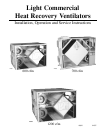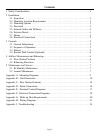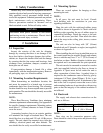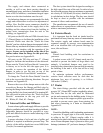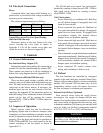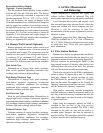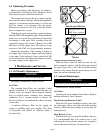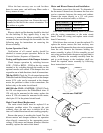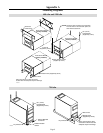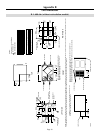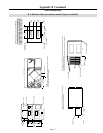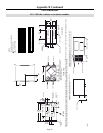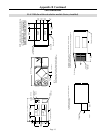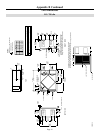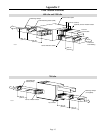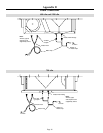
Page 4
The supply and exhaust ducts connected to
outside, as well as any ducts passing through an
unconditioned space, must have a minimum insulation
value of R5. In addition, a continuous integral vapor
barrier over the duct insulation must be used.
Air balancing dampers are recommended for both
supply and exhaust ducts to allow for adjustment of
airflow. Also, flexible canvas connectors should be
installed close to the unit in the supply duct to the
building and the exhaust duct from the building to
reduce noise transmission from the unit to the
building, see Appendix C.
All ports on the 600 cfm and 1200 cfm units have
1" (25mm) flanges to facilitate the installation of the
ductwork. Please note that the "Fresh Air from
Outside" port has a defrost damper incorporated with it.
Ensure that any mechanical fasteners used to connect
the duct do not interfere with the operation of the
damper. Screws can be installed on the side of the
cabinet rather than the flange for this port only.
For port locations see Appendix B.
All ports on the 700 cfm unit have 2" (51mm)
flanges to facilitate the installation of the ductwork.
Please note the "Fresh Air From Outside" connection
is factory set to be the left side upper port. It is
possible to reverse the operation of the defrost
damper in order to use the port on top of the
cabinet for "Fresh Air From Outside" connection.
To change the "Fresh Air From Outside" from the
side to the top use the following directions. For port
locations see Appendix B.
Remove the cover of the damper motor with a flat
screwdriver. Reverse the Orange and Red wires by
moving the Orange from terminal #2 to terminal #3 and
moving the Red wire from terminal #3 to terminal #2.
The end result in order to have the "Fresh Air From
Outside" connection to the top port will be:
#1 - White, #2 - Red, #3 - Orange.
2.5 Internal Grilles and Diffusers
Locate exhaust grilles and supply diffusers to provide
effective ventilation and avoid short circuiting of airflows.
Adjustable dampers should be provided at every
grille and diffuser location to make balancing of the
system possible.
A proper selection of style and size of grilles and
diffusers is required to minimize pressure drop. The
velocity of the airflow should not exceed 400 ft/min
(2 m/sec) for normal applications.
The duct system should be designed according to
the high speed flow rate of the unit. In order to keep
the noise and pressure drop to a minimum, a maximum
air velocity of 1100 ft/min (5.6 m/sec) should be used
in calculations in duct design. The duct runs should
be kept as short as possible with the minimum
amount of elbows and transitions.
The manufacturer recommends the use of smooth
radius elbows or square elbows with turning vanes to
achieve maximum performance.
2.6 Exterior Hoods
It is important that the fresh air intake hood be
positioned well away from any source of contamination.
The exterior supply and exhaust hoods must be
separated enough to prevent cross-contamination
and at an elevation that will prevent blockage by
snow, dirt and leaves.
NOTE:
Consult local building code for restrictions in
your area.
A rodent screen with 1/4" (6mm) mesh must be
installed to prevent the intake of large debris and
animals. A backdraft damper may need to be
installed in the exhaust duct to prevent cold air entering
the building if the unit is to be shut off for a long
period of time.
To maintain optimum airflow performance,
exterior hood selection must be such that the
minimum free area of opening is as follows:
140 inches
2
(0.09m
2
).
2.7 Drains
The drain fittings provided with the unit will
accept a 3/4" (19mm) NPT coupler (supplied by others).
The drain line for the unit must be fabricated
on-site and connected to the building main. A loop in
the hose or trap in the copper or plastic pipe must be
provided to prevent sewer gases from entering the
unit when connecting to a drain as illustrated in
Appendix D.
NOTE:
Consult local building code for plumbing requirements
in your area. If copper pipe is to be used, ensure not
to solder to the 3/4" (19mm) coupler while it is
attached to the plastic drain fitting as deformation may
occur. Ensure adequate slope is present to allow good
drainage (minimum 1/4" per foot or 6mm per 305mm).



